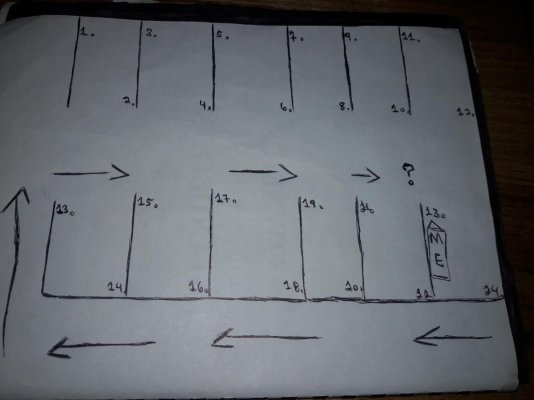South of Heaven
Guru
- Joined
- May 11, 2017
- Messages
- 1,167
- Location
- USA
- Vessel Name
- Slow Lane
- Vessel Make
- 2005 Silverton 35 Motoryacht
Guys, this is my first full season at my marina and I love it! Last year after I bought the boat I came here in late August so I didn't get that much docking experience.
I'm still having a hard time on some days backing into my slip. Not fun! I drew a kindergarten level representation of my dock and slip.
My slip is represented as number 23. I'm at the last slip on starboard side when coming down my row. Each berth has 2 boats. My slip is a port side tie in and I dock stern in.
So obviously this depends on wind direction (there are almost no currents to contend with). Some of my usual problems are as follows:
Scenario #1. I'll line up too close to slip 22 and then when I make my swing it's too late. Then my bow is being pushed closer to slip 10 and I need it to be directly in front of slip 11.
Scenario #2. To avoid what happens sometimes in scenario #1 I'll be closer to the middle part of the fairway and then when I make the swing I'm really close to slip 11 which is fine but then I overcompensate and my stern is lining up with slip 24.
Scenario #3. I drive in, get in perfectly and don't even bat an eye! This scenario happens fairly often but I wanna increase my numbers!
Some more info. I have a single inboard with a left handed prop. I have a bow thruster also. I have never hit another boat and don't want to start now!
What would you guys do and don't do (by using the slip numbers as points of reference)? Another thing. Are there situations that require more than idle speed? Sometimes I feel like I need more throttle to give a quick burst in a certain direction but usually I don't do it and then lose valuable seconds and miss a chance to correct. Uggh!

I'm still having a hard time on some days backing into my slip. Not fun! I drew a kindergarten level representation of my dock and slip.
My slip is represented as number 23. I'm at the last slip on starboard side when coming down my row. Each berth has 2 boats. My slip is a port side tie in and I dock stern in.
So obviously this depends on wind direction (there are almost no currents to contend with). Some of my usual problems are as follows:
Scenario #1. I'll line up too close to slip 22 and then when I make my swing it's too late. Then my bow is being pushed closer to slip 10 and I need it to be directly in front of slip 11.
Scenario #2. To avoid what happens sometimes in scenario #1 I'll be closer to the middle part of the fairway and then when I make the swing I'm really close to slip 11 which is fine but then I overcompensate and my stern is lining up with slip 24.
Scenario #3. I drive in, get in perfectly and don't even bat an eye! This scenario happens fairly often but I wanna increase my numbers!
Some more info. I have a single inboard with a left handed prop. I have a bow thruster also. I have never hit another boat and don't want to start now!
What would you guys do and don't do (by using the slip numbers as points of reference)? Another thing. Are there situations that require more than idle speed? Sometimes I feel like I need more throttle to give a quick burst in a certain direction but usually I don't do it and then lose valuable seconds and miss a chance to correct. Uggh!

Last edited:

